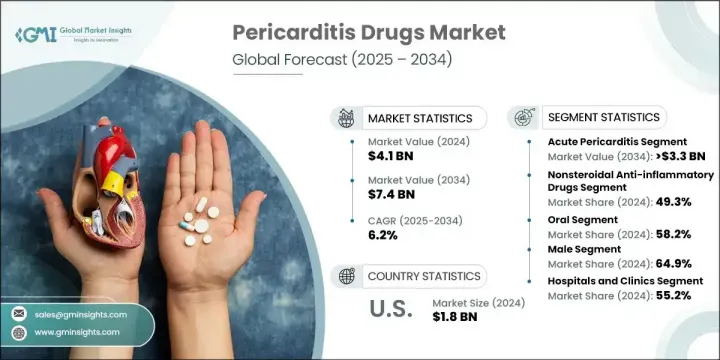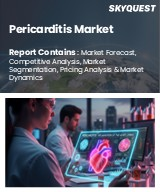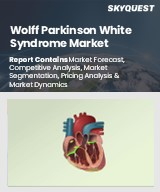
|
시장보고서
상품코드
1797789
심낭염 치료제 시장 기회, 성장 촉진요인, 산업 동향 분석 및 예측(2025-2034년)Pericarditis Drugs Market Opportunity, Growth Drivers, Industry Trend Analysis, and Forecast 2025 - 2034 |
||||||
세계의 심낭염 치료제 시장은 2024년에는 41억 달러로 평가되었으며 CAGR 6.2%를 나타내 2034년에는 74억 달러에 이를 것으로 추정됩니다.
세계의 심혈관 질환률의 상승이 표적 항염증 요법 수요를 크게 촉진하고 있습니다. 이 약들은 심장 주변의 통증과 염증을 최소화하여 급성 및 만성 두 가지 심낭염의 통증 관리에 널리 사용됩니다. 의료기술의 진보와 약물요법의 보급에 따라 보다 효과적인 치료법이 도입되고 있습니다. 신흥국 시장에서의 건강 관리 인프라 개척과 심장 건강에 대한 의식 증가도 시장 성장을 가속화하고 있습니다.

남성에서 심낭염의 이환율이 높으면 바이러스 감염에 대한 염증 반응을 증폭시키는 테스토스테론 수치 상승과 같은 호르몬 요인과 관련이 있다는 조사 보고서가 있습니다. 병원과 심장병 센터가 첨단 약물 요법을 채택하는 경향이 커짐에 따라 전문 치료 옵션에 대한 수요도 증가하고 있습니다. 여러 제약 회사들이 심낭염 치료제의 기술 혁신과 광범위한 접근을 추진하고 있으며, 시장은 기존 지역과 신흥 지역 모두에서 기세를 유지하고 있습니다.
| 시장 범위 | |
|---|---|
| 시작 연도 | 2024년 |
| 예측 연도 | 2025-2034년 |
| 시작 금액 | 41억 달러 |
| 예측 금액 | 74억 달러 |
| CAGR | 6.2% |
2024년 급성 심낭염 부문의 점유율은 46.1%였습니다. 이 부문은 증례 증가, 진단 도구 개선, 관리 경로의 간소화로 꾸준히 성장하고 있습니다. 심혈관계의 건강에서 조기 발견이 중시되게 됨으로써, 병태를 만성화시키는 것이 아니라, 급성 증상을 신속하고 효과적으로 관리하는 것이 보다 강하게 요구되게 되었습니다. 급성기 치료 전략은 증상을 완화하고 염증을 조절하며 추가 합병증을 예방하는 능력으로 주목을 받고 있습니다. 이러한 접근법은 비침습적 진단과 제1선택제, 특히 항염증제에 의존하는 경우가 많으며, 장기 입원 및 복잡한 모니터링의 필요성을 줄이는 데 도움이 되므로 선진국에서도 자원이 제한된 의료 시스템에서도 이상적입니다.
경구제 부문은 2024년에 58.2%의 점유율을 차지했습니다. 이 우위성은 안정적인 전신약 흡수라는 뛰어난 성능과 콜히친이나 비스테로이드성 항염증제 등 일반적으로 배합되는 항염증 치료의 적합성에 기인하고 있습니다. 경구 투여는 사용 편의성, 환자 충격 향상 및 비용 절감과 같은 큰 이점을 제공합니다. 주사약에 비해, 경구약은 외래에서의 사용이 간편하고, 헬스케어 인프라에의 부담도 경감됩니다. 또한 편의성이 높고 집에서 치료 계획을 따를 수 있으므로 환자는 경구 약물 선택을 선호하는 경향이 있습니다.
북미의 심낭염 치료제 시장은 2024년에 46.6%의 점유율을 차지했습니다. 이 호조는 심혈관 질환에 대한 의식 증가와 의료 기술 혁신에 대한 많은 투자가 배경에 있습니다. 이 지역은 1인당 건강 관리 지출이 가장 높은 지역 중 하나이며 고급 진단 및 전문 치료에 대한 액세스가 널리 제공됩니다. 최신 임상 지침의 지속적인 준수는 콜히친 및 면역조절제와 같은 증거 기반 치료법의 사용을 보장합니다. 또한 이 지역에는 의료 인프라가 충실하고, 주요 제약 연구 거점이 존재하기 때문에 새로운 심낭염 치료제의 상용화 사이클이 빠른 속도로 진행되고 있습니다.
세계의 심낭염 치료제 시장에 적극적으로 참여하고 있는 주요 제약 기업으로는 Sun Pharmaceuticals, Bayer, Dr. Reddy's Laboratories, Kiniksa Pharmaceuticals, Teva Pharmaceuticals, AstraZeneca, Novartis, Zydus Cadila, Takeda Pharmaceuticals Lilly, Fosun Pharma 등이 있습니다. 심낭염 치료제로 경쟁하는 기업은 전략적 연구 개발을 통해 신규 제제 개발 및 제품 포트폴리오 확충에 주력하고 있습니다. 많은 기업들이 의료기관이나 연구센터와의 제휴를 활용해 임상 검사를 진행시켜 치료 효과를 최적화하고 있습니다. 특히 인지도와 진단이 향상되고 있는 신흥 시장에서는 세계 유통 채널을 통한 액세스 확대에 중점을 두고 있습니다. 기업은 또한 제약 및 병용 요법의 개발을 포함한 수명주기 관리 전략을 채택하여 제품의 생존 기간을 연장하고 있습니다. 고급 약물전달 시스템과 디지털 어드히어런스 툴의 통합은 치료 성과와 환자 컴플라이언스를 향상시킵니다.
목차
제1장 조사 방법과 범위
제2장 주요 요약
제3장 산업 고찰
- 생태계 분석
- 공급자의 상황
- 각 단계에서의 부가가치
- 밸류체인에 영향을 주는 요인
- 산업에 미치는 영향요인
- 성장 촉진요인
- 심혈관질환의 유병률 증가
- 고령화 인구 증가
- 헬스케어 종사자 사이에서 높아지는 의식
- 병원과 전문의료 네트워크의 확대
- 산업의 잠재적 리스크 및 과제
- 새로운 치료법의 고비용
- 규제와 임상 검사의 장애물
- 시장 기회
- 헬스케어에의 액세스가 확대되는 신흥 시장
- 맞춤형 치료와 표적 치료로의 전환
- 성장 촉진요인
- 성장 가능성 분석
- 규제 상황
- 향후 시장 동향
- 파이프라인 분석
- 특허 상황
- 기술과 혁신의 상황
- Porter's Five Forces 분석
- PESTEL 분석
제4장 경쟁 구도
- 서론
- 기업의 시장 점유율 분석
- 기업 매트릭스 분석
- 주요 시장 기업의 경쟁 분석
- 경쟁 포지셔닝 매트릭스
- 합병과 인수
- 파트너십 및 협업
- 신제품 발매
- 확대 계획
제5장 시장 추정·예측 : 유형별(2021-2034년)
- 주요 동향
- 급성 심낭염
- 재발성 심낭염
- 만성 심낭염
- 기타
제6장 시장 추정·예측 : 약제 클래스별(2021-2034년)
- 주요 동향
- 비스테로이드성 항염증제
- 콜히친
- IL-1 억제제/생물학적 제제
- 기타
제7장 시장 추정·예측 : 투여 경로별(2021-2034년)
- 주요 동향
- 경구
- 비경구
제8장 시장 추정·예측 : 성별(2021-2034년)
- 주요 동향
- 남성
- 여성
제9장 시장 추정·예측 : 최종 용도별(2021-2034년)
- 주요 동향
- 병원 및 클리닉
- 재택 케어 환경
- 기타
제10장 시장 추정·예측 : 지역별(2021-2034년)
- 주요 동향
- 북미
- 미국
- 캐나다
- 유럽
- 독일
- 영국
- 프랑스
- 스페인
- 이탈리아
- 네덜란드
- 아시아태평양
- 중국
- 일본
- 인도
- 호주
- 한국
- 라틴아메리카
- 브라질
- 멕시코
- 아르헨티나
- 중동 및 아프리카
- 남아프리카
- 사우디아라비아
- 아랍에미리트(UAE)
제11장 기업 프로파일
- AstraZeneca
- Bayer
- Cipla
- Dr. Reddy's Laboratories
- Eli Lilly
- Fosun Pharma
- Kiniksa Pharmaceuticals
- Merck
- Novartis
- Pfizer
- Sun Pharmaceuticals
- Takeda Pharmaceuticals
- Teva Pharmaceuticals
- Zydus Cadila
The Global Pericarditis Drugs Market was valued at USD 4.1 billion in 2024 and is estimated to grow at a CAGR of 6.2% to reach USD 7.4 billion by 2034. Rising cardiovascular disease rates across the globe are significantly driving demand for targeted anti-inflammatory therapies. These medications are widely used for managing both acute and chronic forms of pericarditis by minimizing pain and inflammation around the heart. With advancements in medical technology and the growing use of drug regimens, more effective treatments are being introduced. Expanding healthcare infrastructure in developing nations and a rise in cardiac health awareness are also accelerating market growth.

Studies indicate a higher incidence of pericarditis among men, which is linked to hormonal factors such as elevated testosterone levels that amplify inflammatory responses to viral infections. As hospitals and cardiology centers increasingly adopt advanced drug therapies, the demand for specialized treatment options continues to climb. Several pharmaceutical companies are pushing for innovation and broader access to pericarditis medications, ensuring the market maintains its momentum across both established and emerging regions.
| Market Scope | |
|---|---|
| Start Year | 2024 |
| Forecast Year | 2025-2034 |
| Start Value | $4.1 Billion |
| Forecast Value | $7.4 Billion |
| CAGR | 6.2% |
The acute pericarditis segment held a 46.1% share in 2024. This segment is growing steadily due to a rise in cases, better diagnostic tools, and more streamlined care pathways. Increasing focus on early detection in cardiovascular health has prompted a stronger preference for managing acute symptoms quickly and effectively, rather than allowing conditions to advance to chronic stages. Acute care strategies are gaining attention for their ability to alleviate symptoms, control inflammation, and prevent further complications. These approaches often rely on non-invasive diagnostics and first-line medications, especially anti-inflammatory agents, which help reduce the need for extended hospital stays or complex monitoring, making them ideal for both advanced and resource-limited healthcare systems.
The oral formulations segment accounted for a 58.2% share in 2024. This dominance stems from their superior performance in delivering consistent systemic drug absorption and their compatibility with commonly prescribed anti-inflammatory treatments such as colchicine and NSAIDs. Oral administration offers significant advantages, including ease of use, better patient adherence, and cost savings. Compared to injectable drugs, oral medications are simpler to use in outpatient settings and reduce the burden on the healthcare infrastructure. Patients also tend to favor oral options due to their convenience and the ability to follow treatment plans at home.
North America Pericarditis Drugs Market held a 46.6% share in 2024. This strong performance is fueled by higher awareness of cardiovascular disorders and significant investment in medical innovation. The region benefits from some of the highest healthcare spending per capita, offering widespread access to advanced diagnostics and specialized treatment. Continued adherence to updated clinical guidelines ensures evidence-based use of therapies like colchicine and immune-modulating agents. The robust presence of medical infrastructure and leading pharmaceutical research hubs in this region also supports a fast-paced commercialization cycle for emerging pericarditis drugs.
Key pharmaceutical companies actively involved in the Global Pericarditis Drugs Market include Sun Pharmaceuticals, Bayer, Dr. Reddy's Laboratories, Kiniksa Pharmaceuticals, Teva Pharmaceuticals, AstraZeneca, Novartis, Zydus Cadila, Takeda Pharmaceuticals, Merck, Pfizer, Cipla, Eli Lilly, and Fosun Pharma. Companies competing in the pericarditis drugs landscape are focusing on developing novel drug formulations and expanding their product portfolios through strategic research and development. Many are leveraging partnerships with healthcare institutions and research centers to advance clinical trials and optimize treatment efficacy. Emphasis is placed on expanding access through global distribution channels, particularly in emerging markets where awareness and diagnosis are improving. Firms are also adopting lifecycle management strategies, including the development of generic versions and combination therapies, to extend product viability. Integration of advanced drug delivery systems and digital adherence tools enhances treatment outcomes and patient compliance.
Table of Contents
Chapter 1 Methodology and Scope
- 1.1 Market scope and definitions
- 1.2 Research design
- 1.2.1 Research approach
- 1.2.2 Data collection methods
- 1.3 Data mining sources
- 1.3.1 Global
- 1.3.2 Regional/country
- 1.4 Base estimates and calculations
- 1.4.1 Base year calculation
- 1.4.2 Key trends for market estimation
- 1.5 Primary research and validation
- 1.5.1 Primary sources
- 1.6 Forecast model
- 1.7 Research assumption and limitations
Chapter 2 Executive Summary
- 2.1 Industry 3600 synopsis
- 2.2 Key market trends
- 2.2.1 Regional
- 2.2.2 Type trends
- 2.2.3 Drug class trends
- 2.2.4 Route of administration trends
- 2.2.5 Gender trends
- 2.2.6 End use trends
- 2.3 CXO perspectives: Strategic imperatives
- 2.3.1 Key decision points for industry executives
- 2.3.2 Critical success factors for market players
- 2.4 Future outlook and strategic recommendations
Chapter 3 Industry Insights
- 3.1 Industry ecosystem analysis
- 3.1.1 Supplier landscape
- 3.1.2 Value addition at each stage
- 3.1.3 Factor affecting the value chain
- 3.2 Industry impact forces
- 3.2.1 Growth drivers
- 3.2.1.1 Increasing prevalence of cardiovascular diseases
- 3.2.1.2 Rising geriatric population
- 3.2.1.3 Growing awareness among healthcare professionals
- 3.2.1.4 Expansion of hospital and specialty care networks
- 3.2.2 Industry pitfalls and challenges
- 3.2.2.1 High cost of novel therapies
- 3.2.2.2 Regulatory and clinical trial hurdles
- 3.2.3 Market opportunities
- 3.2.3.1 Emerging markets with rising healthcare access
- 3.2.3.2 Shift toward personalized and targeted therapies
- 3.2.1 Growth drivers
- 3.3 Growth potential analysis
- 3.4 Regulatory landscape
- 3.4.1 North America
- 3.4.2 Europe
- 3.4.3 Asia Pacific
- 3.4.4 Latin America
- 3.4.5 Middle East and Africa
- 3.5 Future market trends
- 3.6 Pipeline analysis
- 3.7 Patent landscape
- 3.8 Technology and innovation landscape
- 3.9 Porter's analysis
- 3.10 PESTEL analysis
Chapter 4 Competitive Landscape, 2024
- 4.1 Introduction
- 4.2 Company market share analysis
- 4.3 Company matrix analysis
- 4.4 Competitive analysis of major market players
- 4.5 Competitive positioning matrix
- 4.6 Key developments
- 4.6.1 Merger and acquisition
- 4.6.2 Partnership and collaboration
- 4.6.3 New product launches
- 4.6.4 Expansion plans
Chapter 5 Market Estimates and Forecast, By Type, 2021 - 2034 ($ Mn)
- 5.1 Key trends
- 5.2 Acute pericarditis
- 5.3 Recurrent pericarditis
- 5.4 Chronic pericarditis
- 5.5 Other types
Chapter 6 Market Estimates and Forecast, By Drug Class, 2021 - 2034 ($ Mn)
- 6.1 Key trends
- 6.2 Nonsteroidal anti-inflammatory drugs
- 6.3 Colchicine
- 6.4 IL-1 inhibitors/biologics
- 6.5 Other drug classes
Chapter 7 Market Estimates and Forecast, By Route of Administration, 2021 - 2034 ($ Mn)
- 7.1 Key trends
- 7.2 Oral
- 7.3 Parenteral
Chapter 8 Market Estimates and Forecast, By Gender, 2021 - 2034 ($ Mn)
- 8.1 Key trends
- 8.2 Male
- 8.3 Female
Chapter 9 Market Estimates and Forecast, By End Use, 2021 - 2034 ($ Mn)
- 9.1 Key trends
- 9.2 Hospitals and clinics
- 9.3 Homecare settings
- 9.4 Other end use
Chapter 10 Market Estimates and Forecast, By Region, 2021 - 2034 ($ Mn)
- 10.1 Key trends
- 10.2 North America
- 10.2.1 U.S.
- 10.2.2 Canada
- 10.3 Europe
- 10.3.1 Germany
- 10.3.2 UK
- 10.3.3 France
- 10.3.4 Spain
- 10.3.5 Italy
- 10.3.6 Netherlands
- 10.4 Asia Pacific
- 10.4.1 China
- 10.4.2 Japan
- 10.4.3 India
- 10.4.4 Australia
- 10.4.5 South Korea
- 10.5 Latin America
- 10.5.1 Brazil
- 10.5.2 Mexico
- 10.5.3 Argentina
- 10.6 Middle East and Africa
- 10.6.1 South Africa
- 10.6.2 Saudi Arabia
- 10.6.3 UAE
Chapter 11 Company Profiles
- 11.1 AstraZeneca
- 11.2 Bayer
- 11.3 Cipla
- 11.4 Dr. Reddy's Laboratories
- 11.5 Eli Lilly
- 11.6 Fosun Pharma
- 11.7 Kiniksa Pharmaceuticals
- 11.8 Merck
- 11.9 Novartis
- 11.10 Pfizer
- 11.11 Sun Pharmaceuticals
- 11.12 Takeda Pharmaceuticals
- 11.13 Teva Pharmaceuticals
- 11.14 Zydus Cadila



















